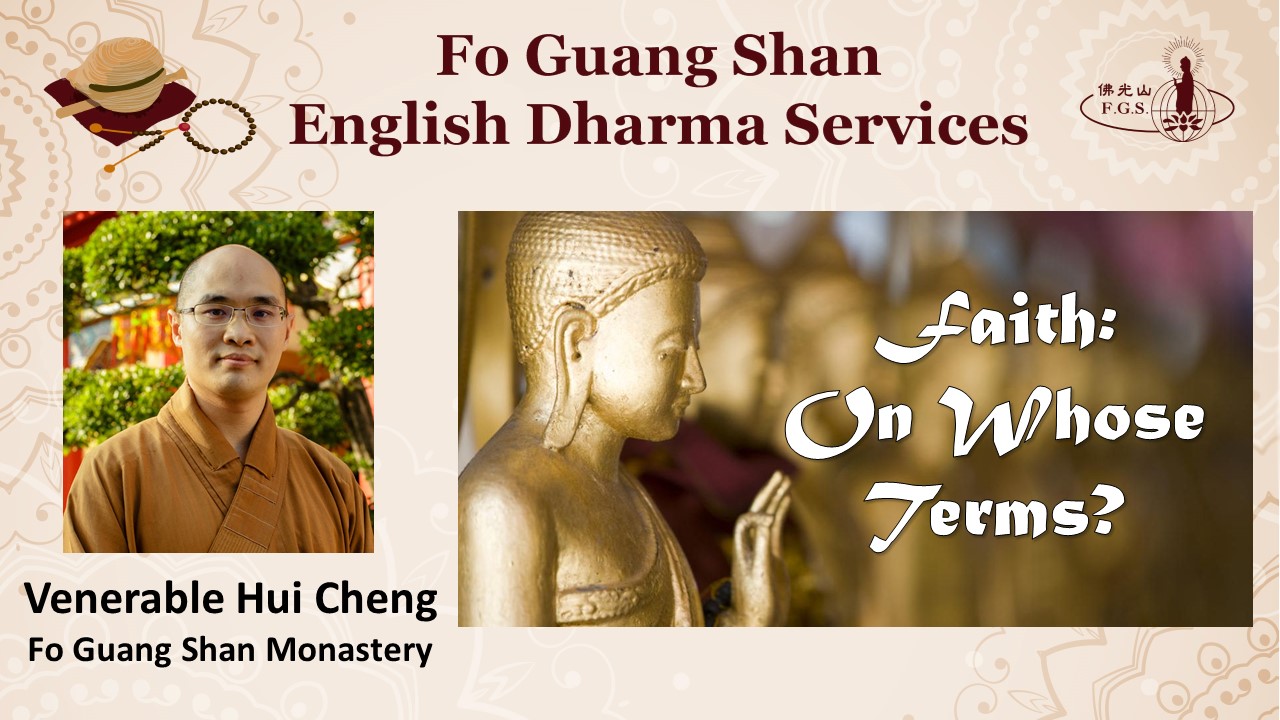
Speaker: Venerable Hui Cheng
Fo Guang Shan Monastery
I. Introduction
Auspicious blessings and welcome to the Fo Guang Shan English Dharma Services Channel. My name is Hui Cheng from Fo Guang Shan Monastery. Today we will be reflecting on the meaning of faith and looking at faith from different perspective.
II. Defining Faith
In the 21st century, the word “faith” has become a much-discussed word. In the turbulent times we find ourselves in, people are more than ever finding themselves in moral and psychological vacuums, where the mind-boggling speed of advancement in knowledge, science, technology, and overall material abundance have failed to address the spiritual wellbeing of humanity.
To this end, humans have resorted to seeking the truth of life. This seeking of truth is inspired by the congenital survival mechanism of seeking freedom from suffering and searching for happiness and inner peace. Due to our differences in socio-cultural upbringings and personal inclinations, our understanding of truth varies considerably, and along our journey of discovering this truth, the definition of truth yet again undergoes transformation.
However, what drives us to continue this journey of truth-seeking is faith. The truth that we provisionally hold trust in, is our object of faith. Without faith, we lack the motivation to continue our journey of truth-seeking. Likewise, the nature of truth that we hold true to, determines the outcome of such truth-seeking. As such, having the right approach to faith, and having faith in a truth that ultimately serves the end of liberation from suffering and attainment of happiness is paramount. It is hoped that during this session, we may reflect on our own personal understanding of faith.
III. Faith vs. Religion
Whenever we speak of faith, what usually comes to mind is religion. It is important to understand that faith is entire trust and confidence in someone or something, whereas religion is a specific social-cultural system of designated behaviors, practices, worship, morals, beliefs, worldviews, texts, sanctified places, or organizations, sometimes encompassing a code of ethics and philosophy, that relates humanity to the Truth or a higher being. The two terms faith and religion are often complimentary in practice, though either could be lacking in our quest for seeking the Truth. Having faith does not automatically equate to belief in a religion and being religious does not guarantee that faith is present. It is becoming more and more commonplace for people to identify with a certain religion, and perhaps even follow the customs and behaviors of the religion while having faith in one’s own constructed worldview and life philosophy, sometimes quite different from one’s religion. Perhaps it may help to put the definitions of faith and religion side-by-side to highlight the differences and relationship between the two terms.
| Faith | Religion |
| Complete trust and confidence in something or someone | A specific system of belief and/or worship |
| An inner emotion | Religion is an external practice or expression |
| Cornerstone of religion | Cannot exist and spread without faith |
Whereas one may be brought up in a religious household, one’s faith in a religion is based on one’s personal experience of it, and whether faith is present comes down to internal mechanisms. When we are inspired to place trust in a religion, then faith is established, without faith, religious praxis becomes mechanical, and most likely for the sake of social conformity. To reap the desired outcomes of religious practice, one needs to invest both mind and manner. As such, only when one has established faith in one’s religious practice, may it be truly rewarding.
IV. Right Faith
The most ideal religion is one of correct faith, which is subject to a few conditions. First, does the object of your faith have historical or factual significance? Second, is it moral and compassionate? Third, can the object of your faith assist others in need? Fourth, does it assist in the purification of one’s character? To put it another way, faith should be placed in figures who are compassionate, moral, wise, and capable characters. Faith should be placed in one who can truly assist us in overcoming afflictions and transcending perpetual suffering. Then and only then is the object of faith deserving of our trust.
V. Blind Faith vs Rational Faith: The Buddhist perspective
Many truths have been taught since time immemorial. However, not all truths lead to the eternal transcendence from suffering. Fortunately, there are guidelines in determining whether a truth serves the purpose offering one true freedom from suffering. So long as a truth answers the following questions, then that truth leads to the goal of true and sustained joy free of dissatisfaction.
Is it Universal? Does the truth apply to all sentient beings without exception?
Is it Inevitable? Are the causal aspects of the truth bound to occur without exception?
Is it Equal? Does the truth apply to all sentient beings irrespective of belief or non-belief in the truth?
Is it Original? Does the truth exist from beginningless time even without a religious leader or founder expounding the said truth?
Is it Transcendental? Does the truth empower us to eternally overcome internal and external sufferings without relying on external forces?
Is it Realizable? Are the truths potentially realizable by all sentient beings?
VI. Buddhist Faith
The overarching goal of a Buddhist is to transform and transcend the deluded mind, so that one may be awakened to the truth of the universe and be free ultimately from the sufferings of sentient life. Those who aspire towards the Bodhisattva Path takes things further, and vows to liberate all sentient beings in a similar way one is self-liberated. To this end, the Buddha has left as a legacy, the tried and proven path that aligns one’s worldview to that which leads to the truth, and that which guides one’s actions of body, speech and mind towards the accumulation of merit and wisdom necessary as a means to the end. However, it is practically impossible for one to progress on the Buddhist path without getting lost in our own lack of understanding and erroneous views and practices.
Just like a patient who has a serious illness cannot cure him or herself, he or she needs to be admitted to a health care facility to seek the help of a doctor to diagnose the illness and prescribe medication and a treatment plan. The patient then requires nurses to administer the treatment plan, monitor recovery and give self-care guidance. Without the doctor, the medication, and the nurses, the patient is unable to be cured. Similarly, according to a Buddhist analogy, the Buddha is the doctor, the medication is the Dharma, and the Sangha are the nurses. Buddhists take the fully enlightened Buddha as their teacher and spiritual guide, the Dharma as the path of practice to remedy the source of suffering, and the Sangha, or community of noble disciples, as their mentor and guide.
As one learns the Dharma as taught by the Buddha, contemplates on it and practices it, one slowly aligns one’s mind to wholesomeness, and positive incremental outcomes are experienced. As such, one is further inspired to strive towards the ultimate goal of transcending suffering and entering the state of sustained joy. As such, Buddhist faith not only aids one in entering the vast ocean of the Dharma, it also provides sustained motivation for progress along one’s spiritual path. However, without learning the Dharma in the first place, it would be highly unlikely for us to self-realize the truths contained in the Dharma. Simply put, without the Buddha teaching us the Dharma, we would not be able to develop the correct mindset and attitude that gives rise to insightful wisdom. As such, we commit ourselves to the Dharma.
The Buddha’s teachings are just as relevant today as it was 2500 years ago, as it deals specifically with the core of the human condition, and the teachings are timeless as they apply universally to people of the past, present and future. However, it is worthy to note that the Buddha is no longer physically present on Earth. Moreover, it was the Buddha’s noble disciples who preserved his teachings by compiling them into written word and sharing the teachings with others. As such, Buddhists see the community of noble disciples, or Sangha, as their spiritual mentors and guides.
In short, the Buddhist faith is taking refuge in the Buddha, Dharma and Sangha, or Triple Gem as they are collectively referred to, for safety and guidance as we aspire towards our goal of liberation from suffering and sustained joy.
VIII. Conclusion
To wrap up, humans have, since beginningless time, sought the truths that lead to freedom from suffering and yields happiness. Such truths inspire an innate sense of faith in them, as they provisionally satiate one’s seeking. However, not all truths lead one to the quintessential state of sustained happiness and inner peace. The Buddhist understanding of faith is one based on rational investigation and personal verification, inspired by trust in the omniscient Buddha as the teacher, the Dharma as the teachings and the truth, and the Sangha as the harmonious community who serve as our spiritual guides.

